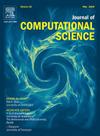A fast method based on variable time steps for 2D nonlinear time-fractional generalized Benjamin–Bona–Mahony–Burgers equation: Error and stability analysis
IF 3.7
3区 计算机科学
Q2 COMPUTER SCIENCE, INTERDISCIPLINARY APPLICATIONS
引用次数: 0
Abstract
This paper presents the stability and convergence analysis of a hybrid scheme that combines the Galerkin-spectral method with a nonuniform time-stepping temporal discretization. The scheme is used to solve the two-dimensional nonlinear time-fractional generalized Benjamin–Bona–Mahony–Burgers equation with admissible regularities. It is widely accepted that fractional differential equations often exhibit singularity near the initial time, which makes uniform time-stepping methods unsuitable to approximate their solution. We convert the problem to an equivalent integral form and then solve it using a reliable time-stepping method with nonuniform time steps. We have developed an unconditionally stable discretization technique that approximates Riemann–Liouville fractional integrals with third-order convergence. Furthermore, we have used the spectral Galerkin method based on the Legendre polynomials for spatial discretization of the mentioned nonlinear problem in two dimensions. Also, we have proved the unconditional stability and convergence of the full-discretization scheme. Using the proposed method, we have conducted several numerical simulations which fully confirmed the theoretical results.
二维非线性时间分数型广义Benjamin-Bona-Mahony-Burgers方程的变时间步长快速求解方法:误差与稳定性分析
本文给出了伽辽金谱法与非均匀时步时间离散相结合的混合方案的稳定性和收敛性分析。该格式用于求解具有可容许规律的二维非线性时间分数型广义Benjamin-Bona-Mahony-Burgers方程。分数阶微分方程在初始时间附近往往表现出奇异性,这使得均匀时间步进法不适合近似其解。我们将问题转化为等效积分形式,然后用一种可靠的时间步长非均匀的方法求解。提出了一种具有三阶收敛性的近似Riemann-Liouville分数阶积分的无条件稳定离散化方法。此外,我们还利用基于勒让德多项式的谱伽辽金方法对上述非线性问题进行了二维空间离散化。同时证明了全离散化方案的无条件稳定性和收敛性。利用所提出的方法进行了多次数值模拟,充分证实了理论结果。
本文章由计算机程序翻译,如有差异,请以英文原文为准。
求助全文
约1分钟内获得全文
求助全文
来源期刊

Journal of Computational Science
COMPUTER SCIENCE, INTERDISCIPLINARY APPLICATIONS-COMPUTER SCIENCE, THEORY & METHODS
CiteScore
5.50
自引率
3.00%
发文量
227
审稿时长
41 days
期刊介绍:
Computational Science is a rapidly growing multi- and interdisciplinary field that uses advanced computing and data analysis to understand and solve complex problems. It has reached a level of predictive capability that now firmly complements the traditional pillars of experimentation and theory.
The recent advances in experimental techniques such as detectors, on-line sensor networks and high-resolution imaging techniques, have opened up new windows into physical and biological processes at many levels of detail. The resulting data explosion allows for detailed data driven modeling and simulation.
This new discipline in science combines computational thinking, modern computational methods, devices and collateral technologies to address problems far beyond the scope of traditional numerical methods.
Computational science typically unifies three distinct elements:
• Modeling, Algorithms and Simulations (e.g. numerical and non-numerical, discrete and continuous);
• Software developed to solve science (e.g., biological, physical, and social), engineering, medicine, and humanities problems;
• Computer and information science that develops and optimizes the advanced system hardware, software, networking, and data management components (e.g. problem solving environments).
 求助内容:
求助内容: 应助结果提醒方式:
应助结果提醒方式:


